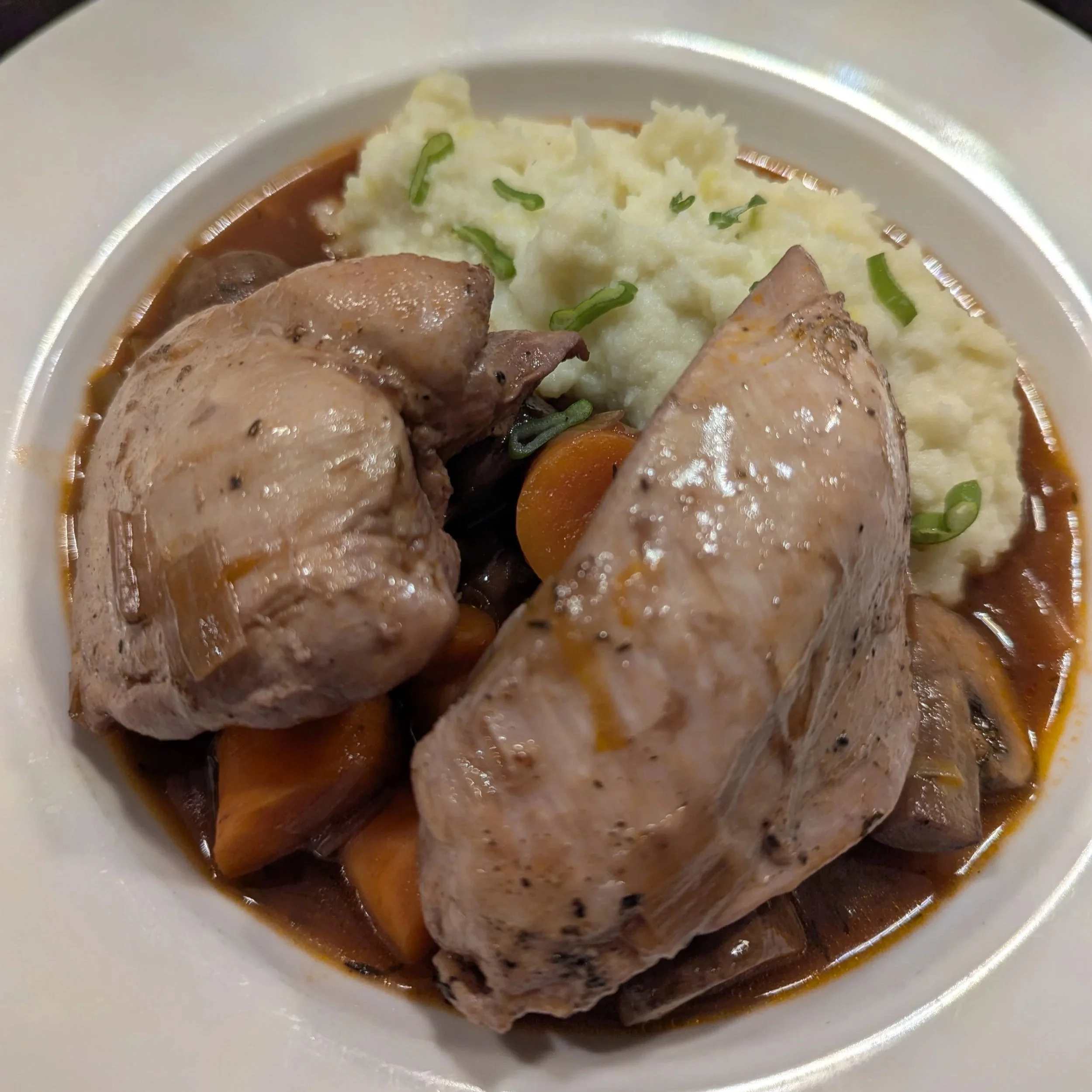Table of Contents
Description | Ingredients | Method | Nutritional Info | Notes And OptionsCalorie-Conscious Coq Au Vin
Inspired by the traditional flavours of Coq Au Vin but tweaked slightly to reduce fat content, this variation on my Braised Beef with Vegetables recipe gives another hearty option that will warm you from the inside during the autumn and winter seasons.
Coq Au Vin is a dish that brings back one of my most vivid, childhood food memories from an unusual setting. We were on a camping trip around BC and Washington State with some family friends in the mid- to late-1980’s, and our friend Yves, who was a chef, somehow whipped up Coq Au Vin on his camper’s meagre stove! The richness of the wine, aromatic herbs, luscious mushrooms and tender chicken was absolutely mind-blowing compared to the regular camping fare we’d been eating up to that point, and has stuck with me ever since.
This variation trades the traditional fatty lardons for lean Tuscany ham, the bone-in, skin-on chicken pieces for boneless, skinless chicken breast, and uses olive oil rather than butter as the cooking fat. All these combine to lighten up the dish considerably while retaining a ton of flavour.
For ease of portioning with the chicken, I prefer to keep it in sizeable, 4-ounce / 75 gram pieces (about half of a chicken breast), so each piece of chicken contains about 20 grams of protein (equivalent to roughly 0.6–1.0 palm portions, depending on your hand size).
Equipment Required
Large dutch oven or stock pot (about 6 quarts / 6 L in size)
Pan for browning chicken pieces
Ingredients (Makes 12 Servings)
1.5 kg / 3 pounds boneless, skinless chicken breast (each breast cut into 2 equal pieces and pre-salted with 2 tsp sea salt for 15-30 minutes)
100 grams lean Tuscany Ham (cut into small pieces)
1 large or 1-1/2 medium onions (diced)
6 carrots (diced or left in larger chunks - up to you)
2 celery sticks (diced)
1 small (156 ml / 5.3 oz.) can tomato paste
1 pound of mushrooms (shiitake or crimini are great, cut in halves or quarters; if you don’t like mushrooms, you could substitute for 3 sweet bell peppers, diced)
750ml / 3 cups chicken broth (OR substitute any portion of the liquid for a full-bodied, dry red wine like a Sangiovese, Malbec, or Syrah)
6 cloves garlic (minced)
2 bay leaves
4 sprigs fresh thyme (or 2 tsp dried thyme)
3 tablespoons extra virgin olive oil
OPTIONAL: 1 TBSP tapioca starch
Method
Preheat your oven to 275 degrees F / 190 degrees C.
Over medium heat in the Dutch oven or stockpot, add 1-1/2 TBSP of olive oil to the pot and fry the Tuscany ham pieces for about 1 minute.
Add the vegetables (onion, carrots, celery and mushrooms or bell peppers) and cook until the onions begin to turn translucent, about 5 minutes.
Add the garlic and cook for another minute or so, then deglaze the pan by adding a little of the broth or wine and scraping all the crusty bits off the bottom of the pot with a wooden spoon.
Add the tomato paste to the pot and mix well with the veg.
Add the herbs and the broth or wine, increase the heat and bring to a low boil, then reduce to a simmer, cover and cook for 15 minutes.
When there’s about 5 minutes left in step 5, working in batches over medium-high heat in a separate pan, brown the chicken pieces on both sides with 2 TBSP of the olive oil and set aside.
When all the chicken pieces are browned, deglaze the pan with a little of the broth from the main pot, then add the chicken pieces and pan juices into the pot with the vegetable and broth, arranging them in a single layer if possible.
Re-cover the pot, transfer to the oven and allow to cook for 25-30 minutes, or until the chicken pieces are fully cooked but moist and tender.
Because of the relative lack of fat and the absence of anything like dredging the chicken pieces in flour before browning, the consistency of the liquid can be a bit thin. For a silkier, richer mouth feel, you can use a tapioca starch slurry to thicken it if you like.
Mix the tapioca starch with 3 TBSP of cold water in a 2-cup measuring cup or bowl. Transfer some of the liquid from the Coq Au Vin into the measuring cup, and stir well to combine (note it may thicken up quickly). Mix the whole thing back into the Dutch oven of Coq Au Vin and combine thoroughly and evenly. The residual heat in the Coq Au Vin should finish thickening it up. If it’s still not thick enough for you, repeat this step with another TBSP of tapioca starch.
Why tapioca starch instead of cornstarch? Cornstarch often needs the mixture it’s being combined with to be brought to a boil to thicken effectively - tapioca starch does not.Enjoy!
Nutritional Info
Absolutely — here's the full analysis in our standard format:
Full Recipe (calculated using all chicken broth for the liquid)
Calories: 3,720 kcal (excluding fiber calories)
Protein:
369 g
1,476 kcal
39.7% of total calories
Fat:
124 g
1,116 kcal
30.0% of total calories
Alcohol: 0 g
0 kcal
0.0% of total calories
Total Carbohydrate: 180 g
Total Fiber: 38 g
Net Carbohydrate:
142 g
568 kcal
15.3% of total calories
Per Serving (1 / 12 of total)
Calories: 310 kcal
Protein:
30.8 g
123 kcal
39.7% of calories
1.0–1.5 palm portions
Fat:
10.3 g
93 kcal
30.0% of calories
0.5–1.0 thumb portions
Total Carbohydrate: 15.0 g
Total Fiber:
3.2 g
Daily fiber % per group:
Women <50: 11.4–12.8%
Men <50: 9.4–10.3%
Women >50: 14.5%
Men >50: 11.4%
Net Carbohydrate:
11.8 g
47 kcal
15.3% of calories
0.5 cupped-palm portions
Fist-sized Portions of Non-Starchy Vegetables:
~6.5 total fists (estimated from onions, carrots, celery, mushrooms)
~0.5–0.6 fists per serving
This nutritional analysis is an estimate only, based on available knowledge regarding the nutritional content of the individual ingredients. Nutritional content of foods is HIGHLY variable, so you should always base your dietary intake on whether it meets your needs and progresses you towards your goals rather than any theoretical numbers on paper.
Notes and Options
For regular / Maintenance eating, you can substitute whole, boneless, skinless chicken thigh pieces for a richer flavour, and could also use butter instead of olive oil for cooking, and bacon or lardons instead of the Tuscany ham. These will each add a bit more fat content to the overall dish, so bear that in mind when considering the overall calorie load.
The nutrition numbers are basically the same whether you use the mushrooms or the bell peppers. Mushrooms are rich in B vitamins and selenium, adding earthy umami flavor and a hearty texture to dishes, while bell peppers are packed with Vitamin C, antioxidants like beta-carotene, and a natural sweetness that enhances brightness and color in recipes. Choosing between them depends on whether you prioritize depth and savoriness (mushrooms) or vibrant flavor and visual appeal (bell peppers).
During On-Protocol weeks, use chicken broth only and do substitute bell peppers for some or all of the mushrooms to give the dish a slightly sweeter overall flavour (which will be missing without the wine).
Substituting wine for all of the chicken broth adds ~72g alcohol (~504 calories) to the recipe total, but after 90 minutes of cooking, only about 15-20 percent of that would be remaining (the rest having evaporated off during cooking), leaving you with about 12-15 grams of alcohol / 84-105 calories total, or about 1-1.3 grams of alcohol / 7-9 calories per serving. With such a minimal net calorie impact, you could get away with using wine even during an On-Protocol week and comfortably remain in a caloric deficit, BUT it would be counter to the idea of avoiding all calorie-containing beverages during On-Protocol weeks…
For an added portion of vegetables or an accompaniment during an On-Protocol week, try some cauliflower-leek mash (pictured above), roasted cauliflower or rutabaga, or blanched or steamed broccoli or broccolini alongside this braise.
For regular / Maintenance week eating, this is great with a piece of homemade sourdough bread for mopping up the sauce, and also works really well with a reasonable portion of roasted, steamed or mashed potatoes, egg noodles, spaetzle or polenta as your starchy carb portion.

